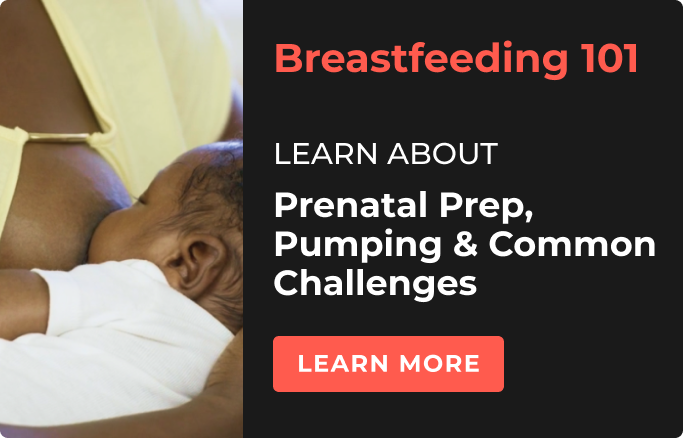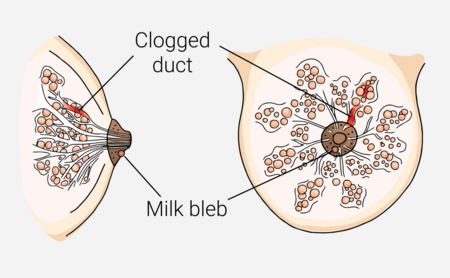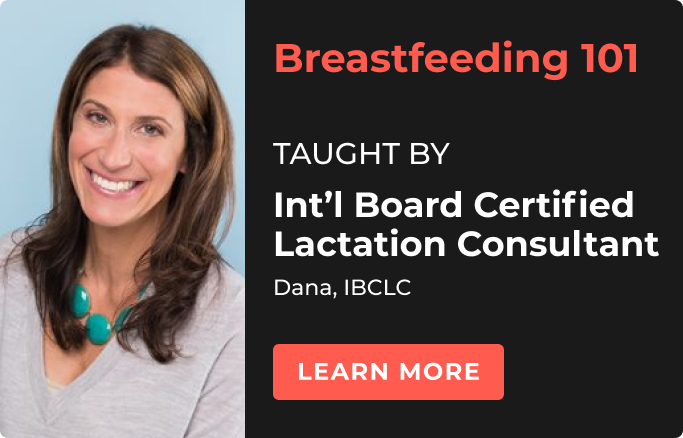In this Ask an Expert, we ask Dana C., professional IBCLC and instructor for our Breastfeeding 101 course, about popping clogged milk ducts. Don’t forget to check out our FREE breastfeeding course, as you prepare for your breastfeeding journey.

Question: Should I pop a clogged milk duct?
In short: no. For various reasons, taking it upon yourself to heal any issue without talking to your healthcare provider first can have an adverse outcome, but mainly because there’s actually nothing to pop when it comes to a clogged milk duct. A symptom of a clogged milk duct is a milk bleb or blister, which may be tempting to pop, however you should not — we’ll get more into that later.
First, let’s take a look at the anatomy of a breast, and what a clogged milk duct actually is. Then, we will go over what happens when you get a clogged milk duct, and what other symptoms you might experience.

What is a clogged milk duct?
As you can see in the diagram above, a clogged milk duct is an internal area of the breast where the milk is obstructed and not flowing normally. Sometimes referred to as blocked or plugged ducts, clogged milk ducts are a common problem for breastfeeding parents. If you suspect you have a clogged milk duct, you will likely experience some or all of the following symptoms:
- A tender or hard spot in the breast that doesn’t resolve after nursing or pumping.
- The breast may be warm to the touch.
- A temporary decrease in milk output from that breast. Don’t worry. It should return once the clog is resolved.
- A milk blister or “bleb” on the tip of the nipple.
How do I resolve a clogged milk duct?
Once you have determined you have a clogged milk duct, don’t panic. There are a few simple steps and actions you can take in order to treat the clogged milk duct at home, and hopefully you can prevent it from turning into mastitis.
What is a Milk Bleb or Blister?
A milk bleb or blister is a small white spot, which looks like a milk-filled blister, on the tip of the nipple. These can occur when nipple pores become blocked, and are often a symptom of a clogged milk duct. The blister may be painful and look yellow or clear.
Should I pop milk bleb or blister?
No, I do not recommend attempting to pop the bleb or blister. Some professionals will lance them; however that is best done by a healthcare professional.
Long term, resolving the clogged duct, will also help resolve the milk bleb. However, to relieve the milk bleb in the meantime, try doing a compress with warm olive oil a few minutes before you nurse.
When should I see a health care provider?
For a clogged milk duct, see a healthcare provider if you have a fever, red streaking on the breast, or start feeling like you have the flu, call your OB or midwife. This could mean the clogged duct has developed into mastitis, and that’s something you cannot treat on your own. Additionally, if it’s been a few days and the clog is not going away or getting worse, call your doctor.
If the milk bleb or blister becomes inflamed, red, and starts oozing or you develop fever, you should see your healthcare provider. You will know the clogged duct is resolved, simply when you feel better: meaning no more pain, discomfort or pressure in the breast, or any of the symptoms detailed above.
How can I prevent a clogged milk duct?
- Check for potential clogs whenever nursing, pumping, or showering—by feeling for tender spots or lumpy spots that don’t resolve when your breasts are emptied.
- Avoid wearing bras or clothing that are too tight or bras with underwire.
- Keep your breasts comfortable. Don’t skip a nursing or pumping session if you can help it. Remember, you can always hand express if you need relief and you can’t nurse or pump for whatever reason.
- Most importantly, remember, clogged milk duct popping is not a thing that can be done, since a milk duct is inside the breast, and popping a milk bleb or blister can lead to infection. If you think you have a clogged milk duct, and you have a fever or start feeling like you have the flu, call your OB or midwife immediately. This could mean the clogged duct has developed into mastitis (a breast infection) and that’s something you cannot treat on your own.
For more guidance on how to treat clogged ducts, and how to treat and prevent other common breastfeeding challenges, watch our 100% FREE online class Breastfeeding 101: From Prenatal Prep to Pumping.



